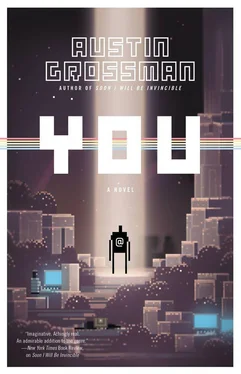Alewife Station, built in the late seventies at the northeastern edge of the subway system, includes a giant concrete parking structure to accommodate commuters from the suburbs. The construction took years. It was a fixture of my childhood, a slow-growing, labyrinthine edifice wrapped in scaffolding and plastic tarps glimpsed from the backseat through rain-spattered car windows on our rare trips into the city.
Dark Lorac walked beside me, tapping the bricks with the Staff of Wizardry, a black rod five feet long surmounted by a small goat skull. We watched cars pull up, moms dropping off kids, dads picking them up. He made a gesture with his staff that seemed to include the garage’s rain-darkened monumental spiral ramps, its sevenfold stack of concrete parking lots, its handicapped access ramps leading underground.
“This is neither the first nor the greatest Dwarven empire.”
Solar Empires II: The Ten-Thousand-Year Sleepover (1995)
A. We see a black starfield, then the camera (but it’s not a camera, because it’s all computer generated, just a point of reference) pulls back until the field of view takes in an enormous (although it’s hard to judge the scale) cylindrical spacecraft, a metal hulk the color of dirty ice whose meteor-scarred hull and dim, flickering navigation lights give an impression of great age. The point of view moves back and back to take in more of the ship, and then we see that the image is framed by a porthole. The porthole is in turn framed by a metal wall decorated with graffiti and posters for musical groups, and then we see a hand gripping a bar fixed to the wall, a hand wearing black nail polish, anchoring its owner floating by the porthole. This, you realize, is you.
You’re about fourteen, and you’re a girl. You are dressed in a gray jumpsuit with the sleeves cut off, and your pink hair is cut in a short, messy pageboy. There are tattoos on your arms and shoulder and throat and cheekbones, curved designs and numbers in a futuristic font.
Your face is hidden from view as you peer out the porthole at the looming craft, until you turn and appear in profile.
Your character design is an anachronistic mess, a nineties Goth girl in space. You imagine the rest. You are in space, where you have lived all your life. The tattoos are indicative of your home asteroid, your training, and your lineage. You have acne scars and a strong jaw.
You hover over the scene. Added detail comes to you unbidden, from your native instinct to make narrative sense of it. You think you are a chieftain’s daughter. Evidently you have been crying.
B. The next image we see is you again, this time in a bubble-helmeted vacuum suit, plunging like a skydiver toward the drifting spaceship, which now occupies the whole background. Your own craft holds position above you—it is a one-person skimmer, a rounded pop-art fantasy in candy colors. You see yourself grow smaller as you drift down away from the camera (as we inexorably surrender to the metaphor), falling toward the spaceship, until on-screen you shrink to a few last pixels against the immense hull that drifts slowly from bottom left to upper right. The craft is slowly spinning.
As you see yourself dwindle, your sense of the ship’s scale grows by an order of magnitude, then another. You make out features on the surface, towers and canyons marked with green and red and amber lights, and a line where, evidently, a piece of space-borne debris impacted the ship at a shallow angle and plowed along the hull for hundreds of feet, or perhaps miles, for all we can tell.
At the upper right-hand corner is a patch of white, which you mistakenly assume is frost until a piece of blue rotates with cosmic slowness, pixel by pixel, into view, revealing itself as one claw of Ley-R4’s iconic blue falcon.
Not heard is the crackle of static on the radio transmitter back in your ship, and the voice that asks, “Honey? Lyra? I’m sorry.” Or the subvocalized words inaudible even in the close air of your helmet. “Don’t look for me.”
C. The last image is the inner surface of an air lock door. A bright spot appears that travels along the line where the door seals itself against the hull, a conventionalized image of an outer-space break-in. But near the outer edge of the image there seems to be trouble, a burn mark on the wall, piled-up garbage, and what is perhaps the toe of a shoe. The bright spot completes its circuit and the door begins to swing open, and here the cinematic intro ends and the game begins.
Looking out through the portal, you can see a planet, a banded gas giant with a red spot. Last thing you knew, you’d bitten and scratched and fought your way out of the solar system. A thousand years later you were still mired in the solar system, and in the body of a teenage girl. What the hell happened?
“Seriously, Matt, what the fuck happened?”
“So, um, Solar Empires II takes place in what Simon’s notes call a pocket interregnum between the interplanetary and interstellar phases.”
“So we’re not leaving the solar system at all?”
“Not in this one,” he said. “I mean, yeah, the idea is there was an accident in space and all, but the relevant part is that Solar Empires didn’t make that much money so they thought they should try and spin it as an innovative first-person shooter, which turned out to make even less money.”
“So is this a game that sucks?”
“Well, uh, it wasn’t my thing,” he said. “And it got great reviews. I mean, people still talk about it constantly—like, it was ahead of its time and people are still learning from it. Just… no one bought it. Everyone said it was because it starred a girl, until a year later Tomb Raider came out, which of course made a zillion dollars. I guess it was a little different, with, you know, how the model was—”
“The rack.”
“Right. Oh, and one last thing—the whole thing was kind of Lisa’s idea? So… kind of don’t mention it to her, ever?”
Maintenance Deck
The air lock cycles. And the girl, the you in this world, steps into the scene. The suit registers breathable air and she pops the suit’s seal, slowly takes off her helmet.
Absently, you escape out of the tutorial and sweep the mouse from left to right. The viewpoint shifts and the figure on the screen turns to follow.
The room is apparently an antechamber where mechanics prepare for debarkation on routine maintenance missions. It is lined with empty hooks; a few discarded gloves and most of an antique vacuum suit lie haphazardly on the floor, as if the room has been looted in haste. There is a strangely damp smell. The sliding door to the room has been wrenched off its track and lies in one corner.
You should be traversing the space, sucking up weapons and keys and trying switches. Instead you stand still in the half-light. There are at least three layers of sound underneath the silence. A steady buzzing of fluorescent light; a subliminal roar of what might be air circulation. A far-off beeping that could be an alarm.
No one builds like this anymore. With its neo-Barsoomian lines, brutalist exposed surfaces, and big metal planes, it is decadent and utilitarian at the same time, distinctly a ship of the late Solar Wars. That puts it way way back in Simon’s time, just after the Solar Tetrarchy fell and the system-wide Dark Age began. Its solid metal construction would not be remotely practical in the current era. It might be three thousand years old, its mass uncountable tons. Jovian-class, at the very least.
Of course. It’s not a freighter at all, it’s your colony ship, the one you built. It never made it out of the system at all, and nobody knew—for a thousand years the solar system’s inhabitants warred over dwindling resources but believed that at least a better world was being built else-where. But the solar exodus never even happened; we’re still stuck in the Dark Age, and humanity’s future has been drifting derelict, half-lit, its biosphere way past its projected life span and probably slowly leaking out through a dozen minor hull breaches.
Читать дальше





![Ally Carter - [Gallagher Girls 01] I'd Tell You I Love You But Then I'd Have to Kill You](/books/262179/ally-carter-gallagher-girls-01-i-d-tell-you-i-lo-thumb.webp)






